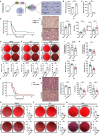A metabolite from commensal Candida albicans enhances the bactericidal activity of macrophages and protects against sepsis
- PMID: 37553429
- PMCID: PMC10541433
- DOI: 10.1038/s41423-023-01070-5
A metabolite from commensal Candida albicans enhances the bactericidal activity of macrophages and protects against sepsis
Abstract
The gut microbiome is recognized as a key modulator of sepsis development. However, the contribution of the gut mycobiome to sepsis development is still not fully understood. Here, we demonstrated that the level of Candida albicans was markedly decreased in patients with bacterial sepsis, and the supernatant of Candida albicans culture significantly decreased the bacterial load and improved sepsis symptoms in both cecum ligation and puncture (CLP)-challenged mice and Escherichia coli-challenged pigs. Integrative metabolomics and the genetic engineering of fungi revealed that Candida albicans-derived phenylpyruvate (PPA) enhanced the bactericidal activity of macrophages and reduced organ damage during sepsis. Mechanistically, PPA directly binds to sirtuin 2 (SIRT2) and increases reactive oxygen species (ROS) production for eventual bacterial clearance. Importantly, PPA enhanced the bacterial clearance capacity of macrophages in sepsis patients and was inversely correlated with the severity of sepsis in patients. Our findings highlight the crucial contribution of commensal fungi to bacterial disease modulation and expand our understanding of the host-mycobiome interaction during sepsis development.
Keywords: Bacterial clearance; Candida albicans; Macrophage; Phenylpyruvate; Sepsis.
© 2023. The Author(s), under exclusive licence to CSI and USTC.
Conflict of interest statement
The authors declare no competing interests.
Figures







Similar articles
-
Oral administration of live- or heat-killed Candida albicans worsened cecal ligation and puncture sepsis in a murine model possibly due to an increased serum (1→3)-β-D-glucan.PLoS One. 2017 Jul 27;12(7):e0181439. doi: 10.1371/journal.pone.0181439. eCollection 2017. PLoS One. 2017. PMID: 28750040 Free PMC article.
-
Gastrointestinal Colonization of Candida Albicans Increases Serum (1→3)-β-D-Glucan, without Candidemia, and Worsens Cecal Ligation and Puncture Sepsis in Murine Model.Shock. 2018 Jan;49(1):62-70. doi: 10.1097/SHK.0000000000000896. Shock. 2018. PMID: 28498297
-
Candida Administration Worsens Cecal Ligation and Puncture-Induced Sepsis in Obese Mice Through Gut Dysbiosis Enhanced Systemic Inflammation, Impact of Pathogen-Associated Molecules From Gut Translocation and Saturated Fatty Acid.Front Immunol. 2020 Sep 25;11:561652. doi: 10.3389/fimmu.2020.561652. eCollection 2020. Front Immunol. 2020. PMID: 33101279 Free PMC article.
-
Gut commensal metabolite rhamnose promotes macrophages phagocytosis by activating SLC12A4 and protects against sepsis in mice.Acta Pharm Sin B. 2024 Jul;14(7):3068-3085. doi: 10.1016/j.apsb.2024.03.025. Epub 2024 Mar 22. Acta Pharm Sin B. 2024. PMID: 39027244 Free PMC article.
-
The human gut mycobiome and the specific role of Candida albicans: where do we stand, as clinicians?Clin Microbiol Infect. 2022 Jan;28(1):58-63. doi: 10.1016/j.cmi.2021.07.034. Epub 2021 Aug 5. Clin Microbiol Infect. 2022. PMID: 34363944 Review.
Cited by
-
LILRA5+ macrophages drive early oxidative stress surge in sepsis: a single-cell transcriptomic landscape with therapeutic implications.Front Cell Infect Microbiol. 2025 Jul 28;15:1606401. doi: 10.3389/fcimb.2025.1606401. eCollection 2025. Front Cell Infect Microbiol. 2025. PMID: 40792106 Free PMC article.
-
Gut Microbiota Metabolites Targeting the Immune Response in Sepsis: Mechanisms and Therapies.Int J Gen Med. 2025 Aug 25;18:4709-4734. doi: 10.2147/IJGM.S539237. eCollection 2025. Int J Gen Med. 2025. PMID: 40894444 Free PMC article. Review.
-
The mycobiome as integral part of the gut microbiome: crucial role of symbiotic fungi in health and disease.Gut Microbes. 2024 Jan-Dec;16(1):2440111. doi: 10.1080/19490976.2024.2440111. Epub 2024 Dec 15. Gut Microbes. 2024. PMID: 39676474 Free PMC article. Review.
-
ACE2 shedding exacerbates sepsis-induced gut leak via loss of microbial metabolite 5-methoxytryptophan.Microbiome. 2025 May 29;13(1):136. doi: 10.1186/s40168-025-02128-4. Microbiome. 2025. PMID: 40442816 Free PMC article.
-
Fungal β-glucan instructed miR-32-5p modulates Dectin-1 signaling mediated inflammation, reactive oxygen species and apoptosis through polarization of "M2a-like" macrophage in Candida colitis.Virulence. 2025 Dec;16(1):2514789. doi: 10.1080/21505594.2025.2514789. Epub 2025 Jun 6. Virulence. 2025. PMID: 40474676 Free PMC article.
References
Publication types
MeSH terms
Grants and funding
LinkOut - more resources
Full Text Sources
Medical
Miscellaneous

